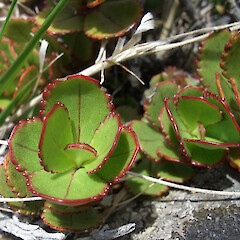Veronica lavaudiana
Common name
Banks Peninsula sun hebe
Synonyms
Hebe lavaudiana (Raoul) Cockayne et Allan; Heliohebe lavaudiana (Raoul) Garn.-Jones; Parahebe lavaudiana (Hook.f.) Heads
Family
Plantaginaceae
Flora category
Vascular – Native
Endemic taxon
Yes
Endemic genus
Yes
Endemic family
No
Structural class
Trees & Shrubs - Dicotyledons
NVS code
The National Vegetation Survey (NVS) Databank is a physical archive and electronic databank containing records of over 94,000 vegetation survey plots - including data from over 19,000 permanent plots. NVS maintains a standard set of species code abbreviations that correspond to standard scientific plant names from the Ngä Tipu o Aotearoa - New Zealand Plants database.
HELLAV
Chromosome number
2n = 42
Current conservation status
The conservation status of all known New Zealand vascular plant taxa at the rank of species and below were reassessed in 2017 using the New Zealand Threat Classification System (NZTCS) – more information about this can be found on the NZTCS website. This report includes a statistical summary and brief notes on changes since 2012 and replaces all previous NZTCS lists for vascular plants.
Please note, threat classifications are often suggested by authors when publications fall between NZTCS assessment periods – an interim threat classification status has not been assessed by the NZTCS panel.
- Conservation status of New Zealand indigenous vascular plants, 2017 . 2018. Peter J. de Lange, Jeremy R. Rolfe, John W. Barkla, Shannel P. Courtney, Paul D. Champion, Leon R. Perrie, Sarah M. Beadel, Kerry A. Ford, Ilse Breitwieser, Ines Schönberger, Rowan Hindmarsh-Walls, Peter B. Heenan and Kate Ladley. Department of Conservation. Source: NZTCS and licensed by DOC for reuse under the Creative Commons Attribution 4.0 International licence.
2017 | At Risk – Declining | Qualifiers: RR
Previous conservation statuses
2012 | At Risk – Declining | Qualifiers: RR
2009 | At Risk – Declining | Qualifiers: OL
2004 | Serious Decline
Brief description
Bushy small shrub bearing pairs of fleshy red-edged rounded toothed leaves inhabiting Banks Peninsula. Twigs fuzzy (lens needed). Leaves 12-25mm long on a short stalk. Flowers pinkish, in rounded clusters to 4cm long, on stalks above leaves.
Distribution
Endemic. Known only from Banks Peninsula.
Habitat
A species of open rock outcrops and cliff faces, often growing in the most exposed sunny habitats.
Detailed description
Spreading, low shrub 100-300 mm tall. Branches prostrate, trailing, branchlets brown or grey. Leaves spreading to recurved, (7-)12-25(-30) x (6-)8-17 mm, dark green, somewhat glaucous, obovate to orbicular, leathery, margins with 3-10 crenations. Petiole narrowly winged, 2-5(-8) mm. Inflorescence 20-40 mm long, (50-)100-150-flowered Calyx 4-5 mm, lobes 5, lanceolate to deltoid, acuminate, glandular ciliate. Corolla 11-13 mm, pink at anthesis, white after pollination, throat white or pink, corolla tube 1.5-2 mm long, 1.7-2 mm wide, slightly expanded, Lateral corolla lobes elliptic, subacute, suberect to spreading, posterior corolla lobe longer than tube, rhomboid, subacute, erect. Stamen filaments white, inserted at base of corolla tube, 2.5 mm long. Anthers yellow. Seeds pale brown, (1.7-)2-2.5 x 0.7-1 mm. Chromosome Number 2n = 42
Similar taxa
Distinguished from the other Veronica species by the round, dull green leaves, long glandular inflorescence hairs, compact inflorescences, pink flower buds, and large white flowers.
Flowering
October to November (-January)
Flower colours
Red/Pink, White
Fruiting
January (-March)
Propagation technique
Easily grown from fresh seed and semi-hardwood cuttings. Requires a free draining, sunny spot with reasonably air movement. Prone to fungal diseases and dislikes high humidity.
Threats
Threatened by gorse (Ulex europaeus) with overshadowed plants and other weeds which are invading the open rock outcrop habitat this species requires.
Etymology
veronica: Named after Saint Veronica, who gave Jesus her veil to wipe his brow as he carried the cross through Jerusalem, perhaps because the common name of this plant is ‘speedwell’. The name Veronica is often believed to derive from the Latin vera ‘truth’ and iconica ‘image’, but it is actually derived from the Macedonian name Berenice which means ‘bearer of victory’.
Where To Buy
Periodically offered by most commercial garden centres. Plants are held by several specialist native plant nurseries.
Attribution
Fact Sheet Prepared by P.J. de Lange (1 November 2004). Description based on Garnock-Jones (1993)
References and further reading
Garnock-Jones, P.J. 1993: Heliohebe (Scrophulariaceae Veroniceae), a new genus segregated from Hebe. New Zealand Journal of Botany 31: 323-339.
Garnock-Jones, P.J.; Albach, D.; Briggs, B.G. 2007: Botanical names in Southern Hemisphere Veronica (Plantaginaceae): sect. Detzneria, ect. Hebe, and sect. Labiatoides. Taxon 56: 571-582
NZPCN Fact Sheet citation
Please cite as: de Lange, P.J. (Year at time of access): Veronica lavaudiana Fact Sheet (content continuously updated). New Zealand Plant Conservation Network. https://www.nzpcn.org.nz/flora/species/veronica-lavaudiana/ (Date website was queried)










